Analysis of the Water Level Variation in the Polish Part of the Vistula Lagoon (Baltic Sea) and Estimation of Water Inflow and Outflow Transport through the Strait of Baltiysk in the Years 2008–2017
Abstract
:1. Introduction
- a statistical analysis of the water level variation at Tolkmicko station to identify the factors of water damming in the southern part (Polish) of the Vistula Lagoon (the measurements of the water stages in the lagoon and in the Gulf of Gdańsk, as well as wind observations at Nowa Pasłęka meteorological station were used for this research),
- a validation of the shallow water equations model [4] adopted to simulate the hydrodynamics of the lagoon over a long period of time (the water stage field measurements from Tolkmicko were used for comparison with the calculations),
- a computational estimation of the marine water transport between the Baltic Sea and the Vistula Lagoon (a numerical simulation of the hydrodynamics of the Vistula Lagoon was carried out for the period 2008–2017).
2. Materials and Methods
2.1. Study Area
2.2. Hydro-Meteorological and Bathymetric Data
2.3. Statistical Method
2.4. Mathematical Model
3. Results and Discussion
3.1. Variability of the Vistula Lagoon Water Levels (WSE) at Tolkmicko
3.2. Validation of the Hydrodynamic Model for the 10-Year-Long Simulation Period
3.3. Water Transport through the Strait of Baltiysk
4. Conclusions
- The Vistula Lagoon 2D hydrodynamic model was verified and the simulation results were validated using water stage elevation measurements at Tolkmicko control point. Although the results obtained for the years 2008–2017 are slightly understated in relation to the observations, the calculations should be considered reliable, which was confirmed by statistical measures.
- The application of the validated hydrodynamic model enabled calculations of the flow through the Strait of Baltiysk. The calculated discharges in the strait provided the data to estimate the total accumulative inflow and outflow of seawater entering and leaving the lagoon, respectively.
- The average annual marine water inflow into the Vistula Lagoon between 2008 and 2017 was calculated to be equal to 15.87 km3. The minimum and maximum total inflows were estimated as 14.31 km3 and 17.78 km3, respectively. These values, although different, are consistent with the data given in historical sources and can be used to update the hydrological balance of the waters of the Vistula Lagoon.
Author Contributions
Funding
Institutional Review Board Statement
Informed Consent Statement
Data Availability Statement
Conflicts of Interest
References
- Kjerfve, B. Coastal Lagoons. In Elsevier Oceanography Series; Kjerfve, B., Ed.; Coastal Lagoon Processes; Elsevier: Amsterdam, The Netherlands, 1994; Volume 60, pp. 1–8. [Google Scholar]
- Bird, E.C.F. Coastal Geomorphology: An Introduction; John Wiley & Sons: Hoboken, NJ, USA, 2011; ISBN 978-1-119-96435-3. [Google Scholar]
- Chubarenko, B.; Domnin, D.; Navrotskaya, S.; Stont, Z.; Chechko, V.; Bobykina, V.; Pilipchuk, V.; Karmanov, K.; Domnina, A.; Bukanova, T.; et al. Transboundary Lagoons of the Baltic Sea. In The Diversity of Russian Estuaries and Lagoons Exposed to Human Influence; Kosyan, R., Ed.; Estuaries of the World; Springer International Publishing: Cham, Switzerland, 2017; pp. 149–189. ISBN 978-3-319-43392-9. [Google Scholar]
- Szydłowski, M.; Kolerski, T.; Zima, P. Impact of the Artificial Strait in the Vistula Spit on the Hydrodynamics of the Vistula Lagoon (Baltic Sea). Water 2019, 11, 990. [Google Scholar] [CrossRef] [Green Version]
- Cieśliński, R.; Lewandowski, A. Hydrological regime of the Vistula Lagoon and the possible changes due to the construction of the waterway connecting the Vistula Bay with the Gulf of Gdansk. Inżynieria Morska Geotech. 2013, 1, 69–78. [Google Scholar]
- Łazarenko, N.N.; Majewski, A. Hydrometeorological System of the Vistula Lagoon; Communication Publishing House: Warsaw, Poland, 1975. [Google Scholar]
- Szymkiewicz, R. Hydrodynamics of Vistula Lagoon; Monography of P.A.S.: Warsaw, Poland, 1992. [Google Scholar]
- Chubarenko, B.V.; Zakirov, R.B. Water Exchange of Nontidal Estuarine Coastal Vistula Lagoon with the Baltic Sea. J. Waterw. Port Coast. Ocean Eng. 2021, 147. [Google Scholar] [CrossRef]
- Bielecka, M.; Kazmierski, J. A 3D Mathematical Model of Vistula Lagoon Hydrodynamics-General Assumptions and Results of Preliminary Calculations. Groundwater 2003, 80, 2–4. [Google Scholar]
- Chubarenko, B.; Margoński, P. The Vistula Lagoon. In Ecology of Baltic Coastal Waters; Schiewer, U., Ed.; Ecological Studies; Springer: Berlin/Heidelberg, Germany, 2008; pp. 167–195. ISBN 978-3-540-73524-3. [Google Scholar]
- Cieśliński, R.; Chlost, I. Water Balance Characteristics of the Vistula Lagoon Coastal Area along the Southern Baltic Sea. Baltica 2017, 30, 107–117. [Google Scholar] [CrossRef]
- Kruk, M.; Kempa, M.; Tjomsland, T.; Durand, D. The use of mathematical models to predict changes in the environment of the Vistula Lagoon. In Vistula Lagoon–Natural Environment and Modern Methods of His Research Project on the Example of Visla; Publishing PWSZ: Elbląg, Poland, 2011; pp. 165–180. [Google Scholar]
- Chubarenko, I.P.; Chubarenko, B.V. General Water Dynamics of the Vistula Lagoon. Environ. Chem. Phys. 2002, 24, 213–217. [Google Scholar]
- Chubarenko, B.; Chubarenko, I.; Baudler, H. Comparison of Darss-Zingst Bodden Chain and Vistula Lagoon (Baltic Sea) in a View of Hydrodynamic Numerical Modelling. Baltica 2005, 18, 56–67. [Google Scholar]
- Takeoka, H. Fundamental Concepts of Exchange and Transport Time Scales in a Coastal Sea. Cont. Shelf Res. 1984, 3, 311–326. [Google Scholar] [CrossRef]
- IMGW-PIB Meteorological and Hydrological Measurement Data. Available online: https://dane.imgw.pl/data/dane_pomiarowo_obserwacyjne/ (accessed on 17 April 2020).
- Szydłowski, M.; Artichowicz, W.; Zima, P. Dataset: Analysis of the Water Level Variation at the Polish Part of the Vistula Lagoon (2008–2017). Gdańsk Univ. Technol. 2021. Most Wiedzy. [Google Scholar] [CrossRef]
- Kenney, J.F.; Keeping, E.S. Mathematics of Statistics, 2nd ed.; Princeton Van Nostrand: New York, NY, USA, 1951; Volume 2. [Google Scholar]
- Boes, D.C.; Graybill, F.A.; Mood, A.M. Introduction to the Theory of Statistics, 3rd ed.; McGraw-Hill: New York, NY, USA, 1974. [Google Scholar]
- Shumway, R.H.; Stoffer, D.S. Time Series Analysis and Its Applications: With R Examples, 4th ed.; Springer Texts in Statistics; Springer International Publishing: Berlin/Heidelberg, Germany, 2017; ISBN 978-3-319-52451-1. [Google Scholar]
- Anaconda Software Distribution. Computer Software. Available online: https://anaconda.com (accessed on 25 September 2020).
- Python Software Foundation. The Python Language Reference, Version 3.8. Available online: https://docs.python.org/3.8/reference/ (accessed on 25 September 2020).
- Szymkiewicz, R. A Mathematical Model of Storm Surge in the Vistula Lagoon, Poland. Coast. Eng. 1992, 16, 181–203. [Google Scholar] [CrossRef]
- Catewicz, Z.; Jankowski, A. Model H-N of stationary flows in Vistula Lagoon. Podstawy Gospod. Sr. Mor. III Studia Mater. Oceanol. 1983, 40, 223–249. [Google Scholar]
- Kolerski, T.; Zima, P.; Szydłowski, M. Mathematical Modeling of Ice Thrusting on the Shore of the Vistula Lagoon (Baltic Sea) and the Proposed Artificial Island. Water 2019, 11, 2297. [Google Scholar] [CrossRef] [Green Version]
- Szymkiewicz, R. Analysis of a concept of changing the hydrodynamic conditions of the Vistula Lagoon. Inżynieria Morska 1984, 6, 258–260. [Google Scholar]
- Chubarenko, I.; Tchepikova, I. Modelling of Man-Made Contribution to Salinity Increase into the Vistula Lagoon (Baltic Sea). Ecol. Model. 2001, 138, 87–100. [Google Scholar] [CrossRef]
- Kwiatkowski, J.; Rasmussen, E.K.; Ezhova, E.; Chubarenko, B. The eutrophication model of the Vistula Lagoon. Oceanol. Stud. 1997, 26, 5–33. [Google Scholar]
- Chubarenko, B.; Chechko, V.; Kileso, A.; Krek, E.; Topchaya, V. Hydrological and Sedimentation Conditions in a Non-Tidal Lagoon during Ice Coverage—The Example of Vistula Lagoon in the Baltic Sea. Estuar. Coast. Shelf Sci. 2019, 216, 38–53. [Google Scholar] [CrossRef]
- Chubarenko, B.V.; Leitsina, L.V.; Esiukova, E.E.; Kurennoy, D.N. Model Analysis of the Currents and Wind Waves in the Vistula Lagoon of the Baltic Sea. Oceanology 2012, 52, 748–753. [Google Scholar] [CrossRef]
- Stelling, G.S. On the Construction of Computational Methods for Shallow Water Flow Problems; Rijkwaterstaat Comunications: The Hague, The Netherlands, 1983. [Google Scholar]
- Szymkiewicz, R. Oscillation-Free Solution of Shallow Water Equations for Nonstaggered Grid. J. Hydraul. Eng. 1993, 119, 1118–1137. [Google Scholar] [CrossRef]
- Piñeiro, G.; Perelman, S.; Guerschman, J.P.; Paruelo, J.M. How to Evaluate Models: Observed vs. Predicted or Predicted vs. Observed? Ecol. Model. 2008, 216, 316–322. [Google Scholar] [CrossRef]
- James, G.; Witten, D.; Hastie, T.; Tibshirani, R. An Introduction to Statistical Learning: With Applications in R; Springer Texts in Statistics; Springer: New York, NY, USA, 2013; ISBN 978-1-4614-7137-0. [Google Scholar]
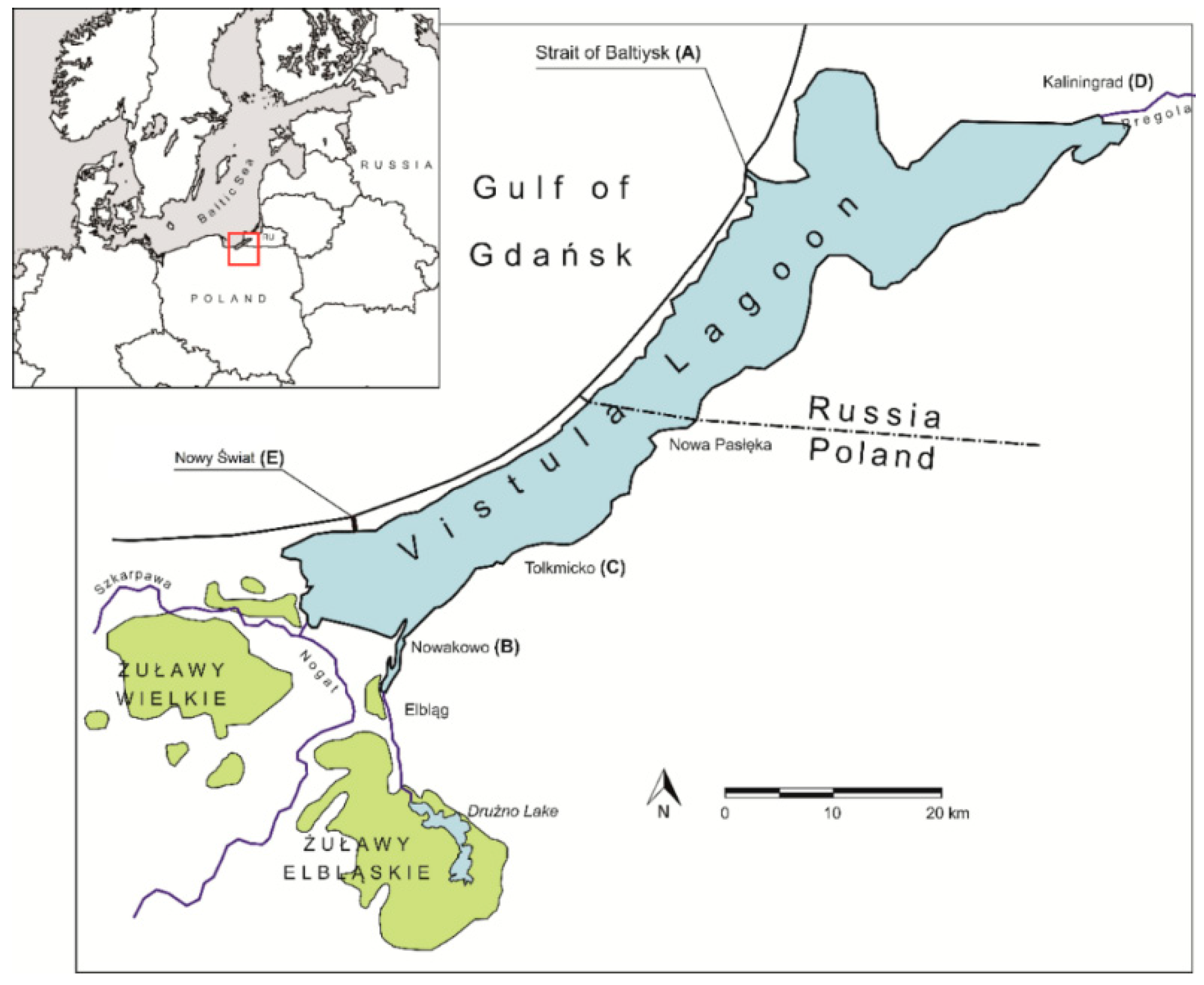


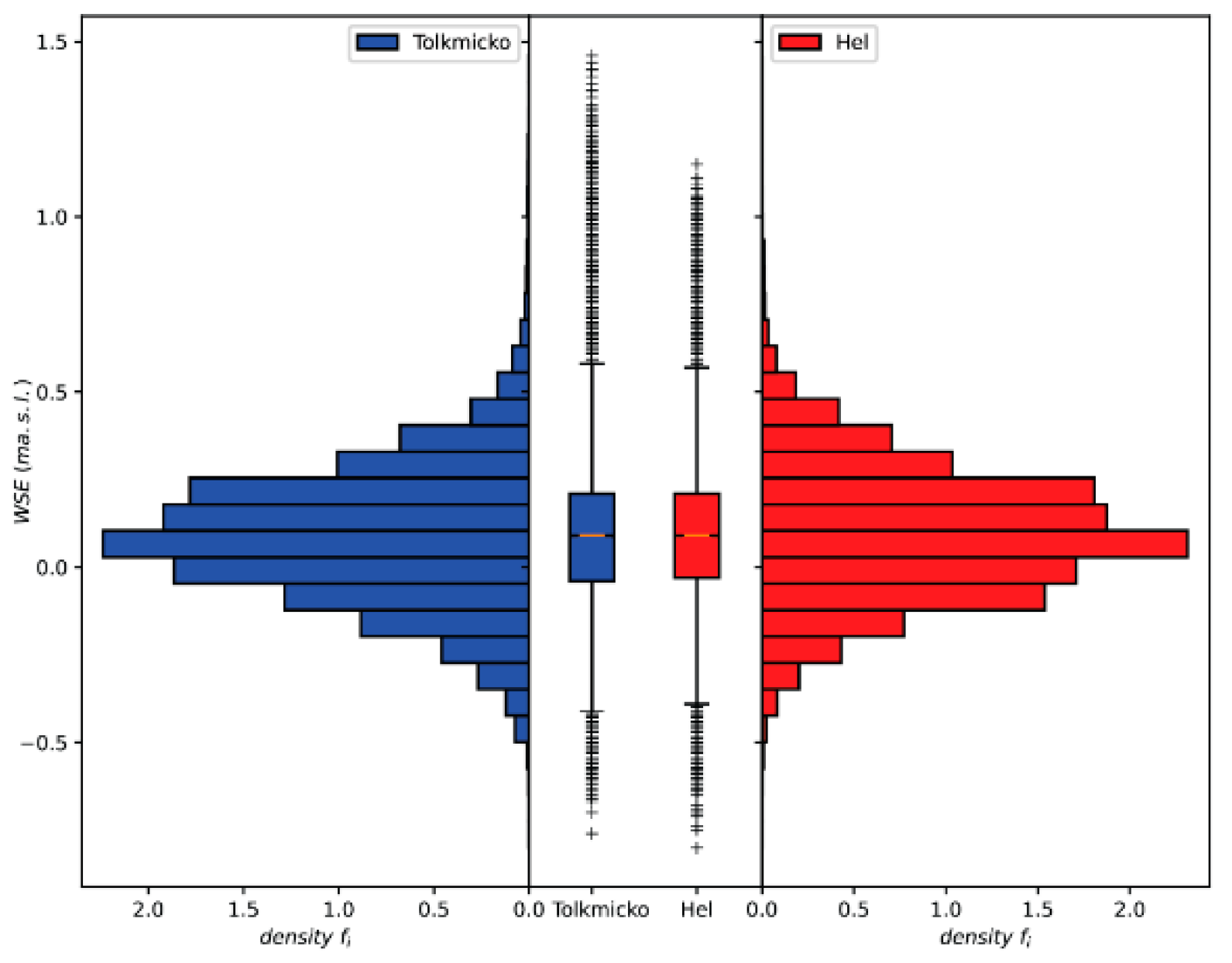
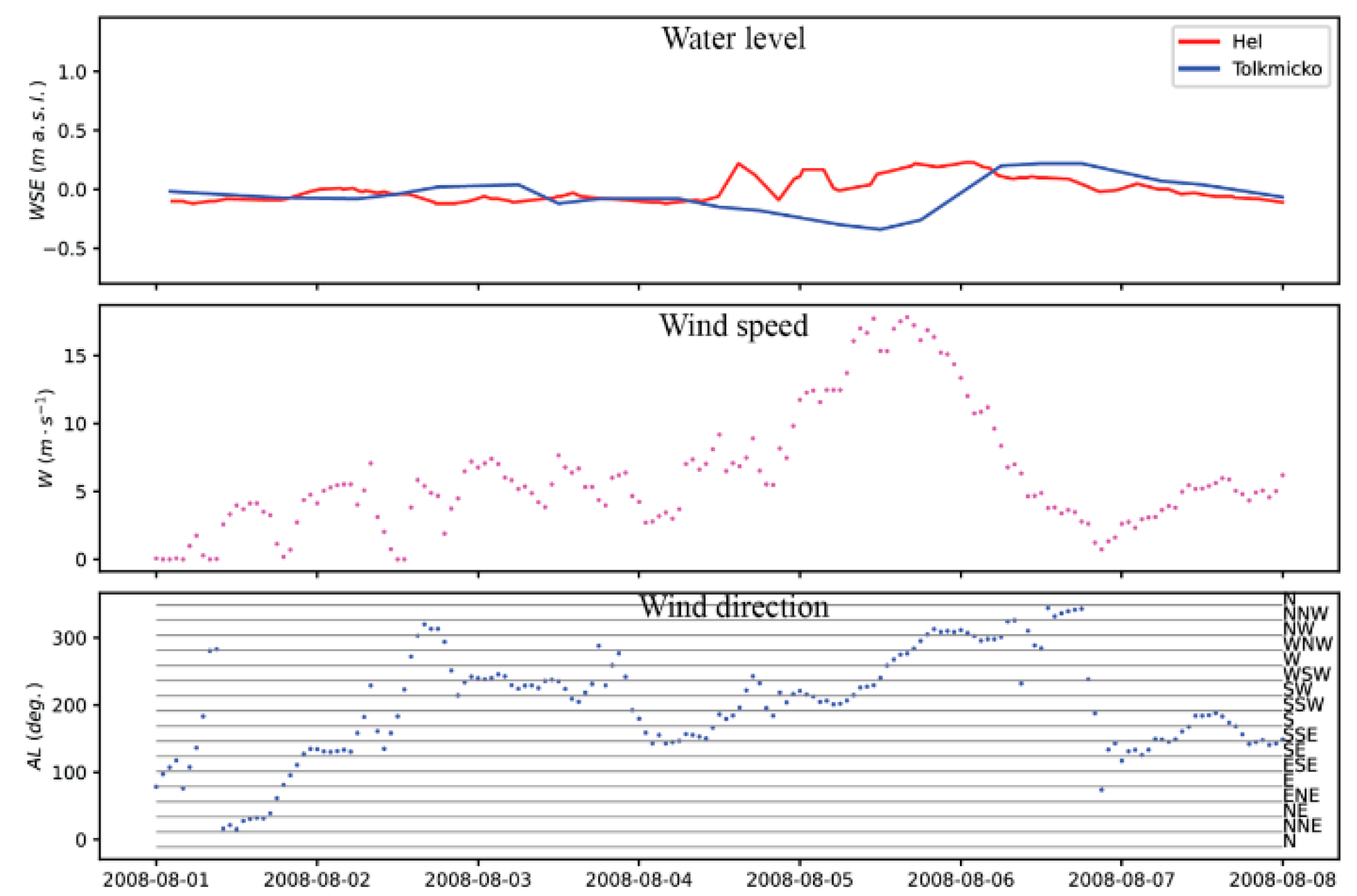
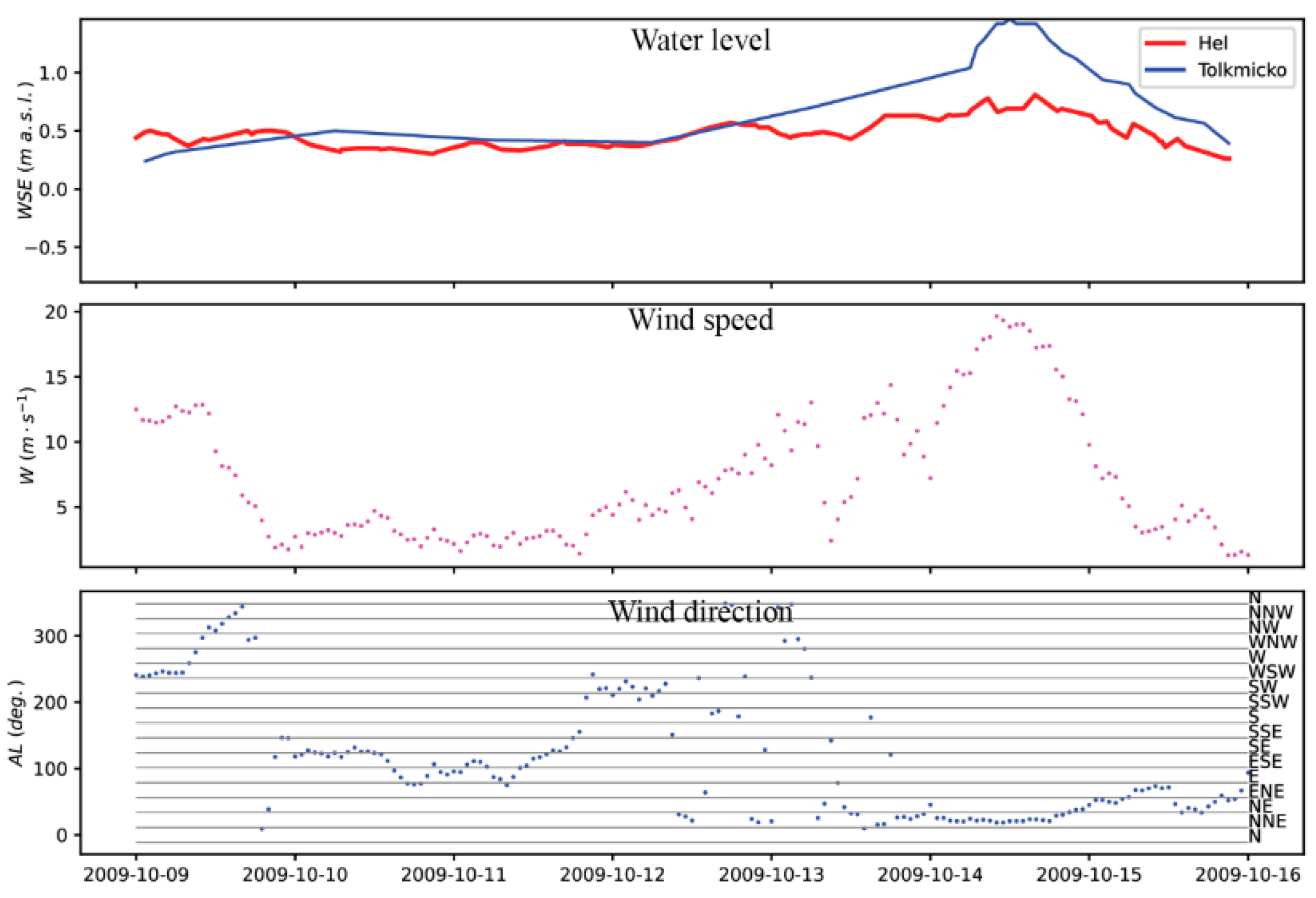
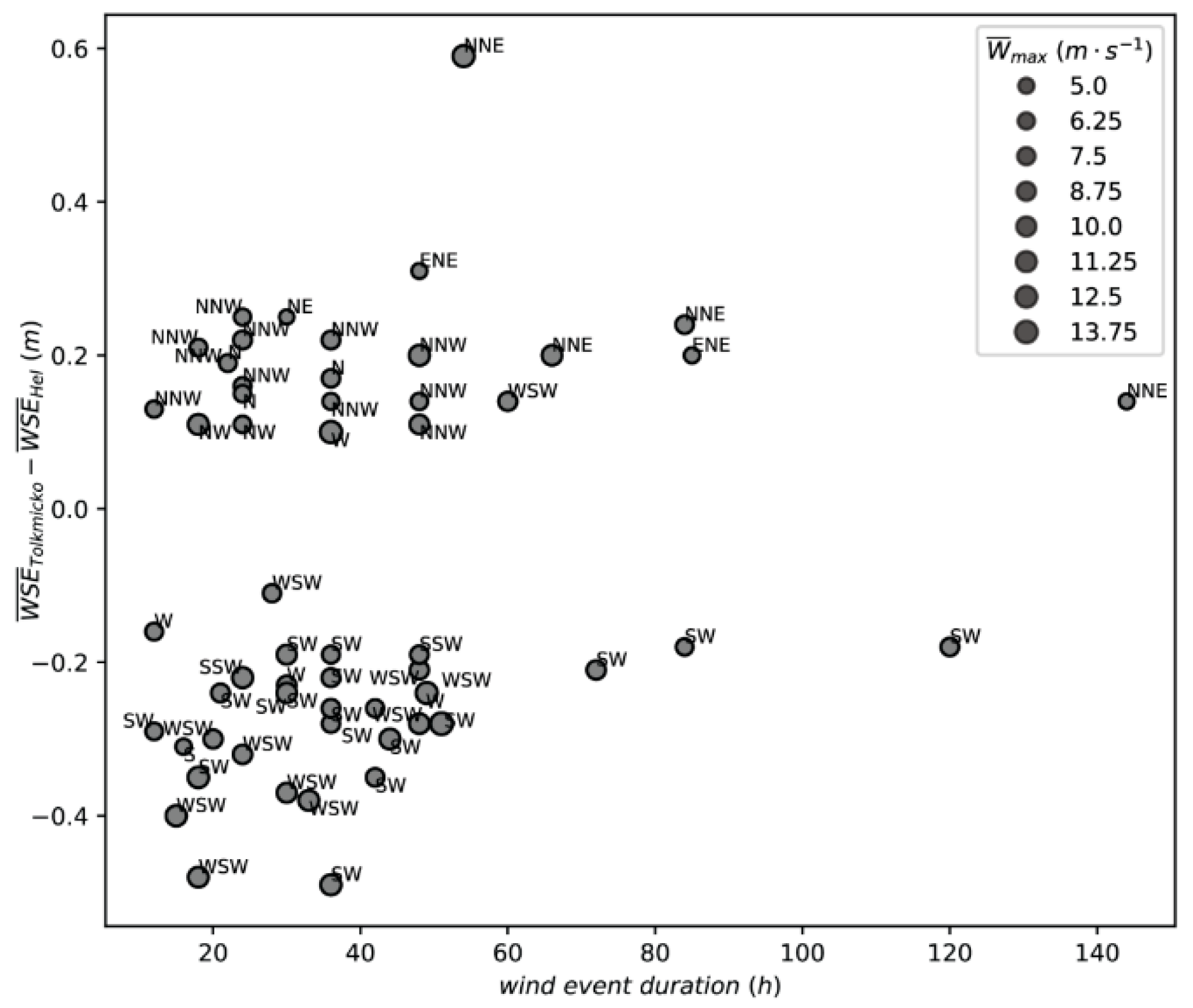
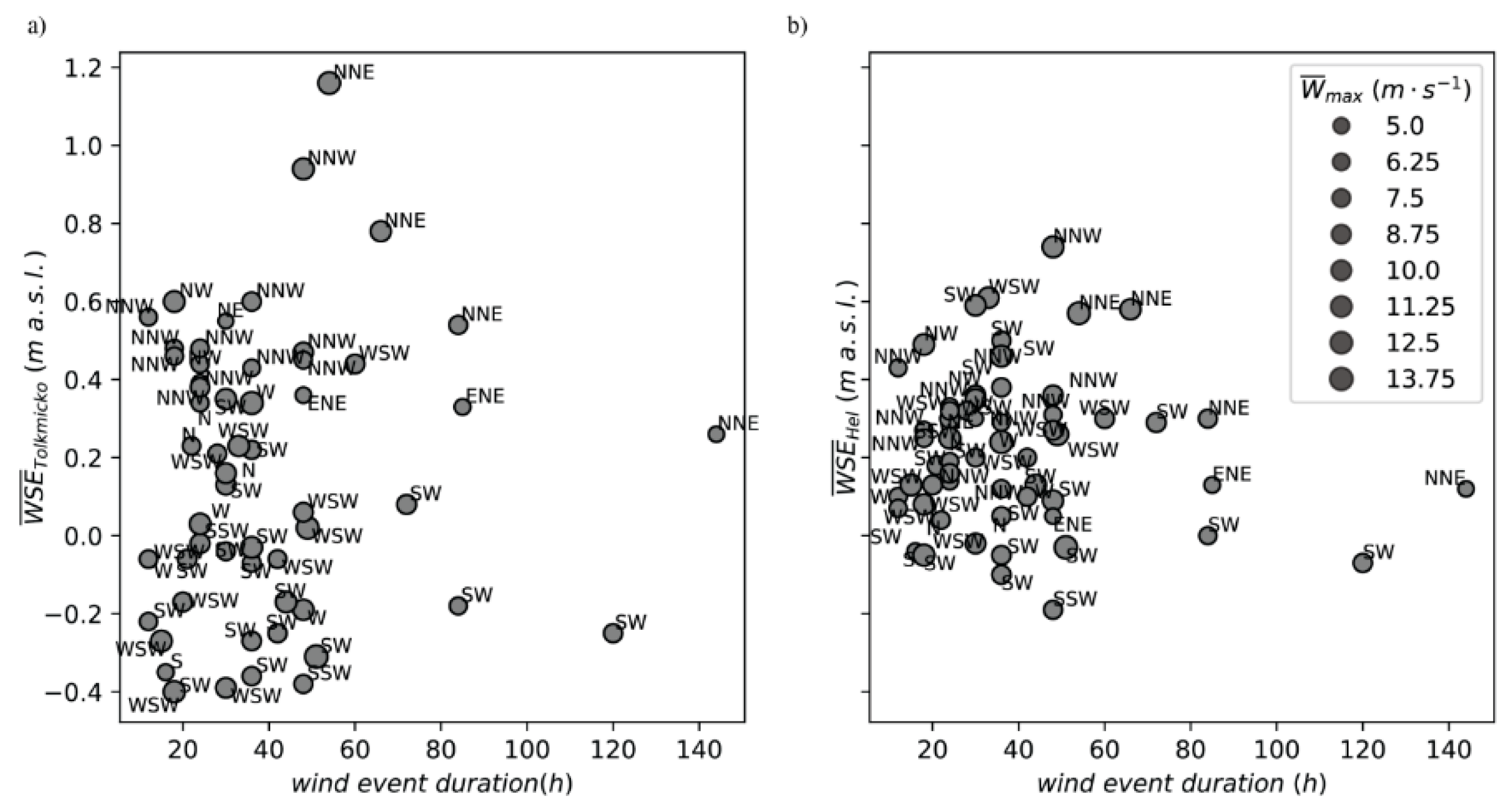
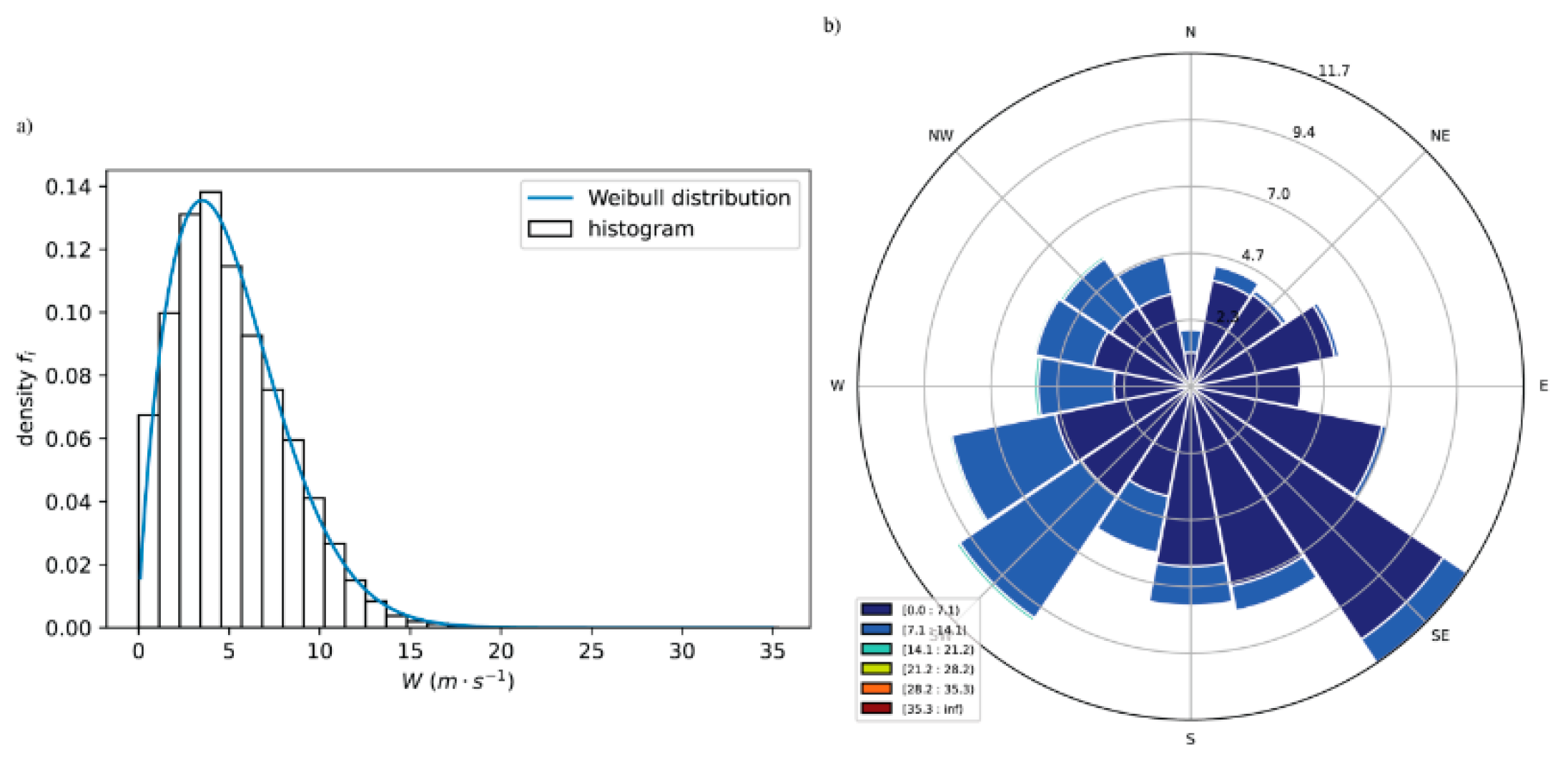
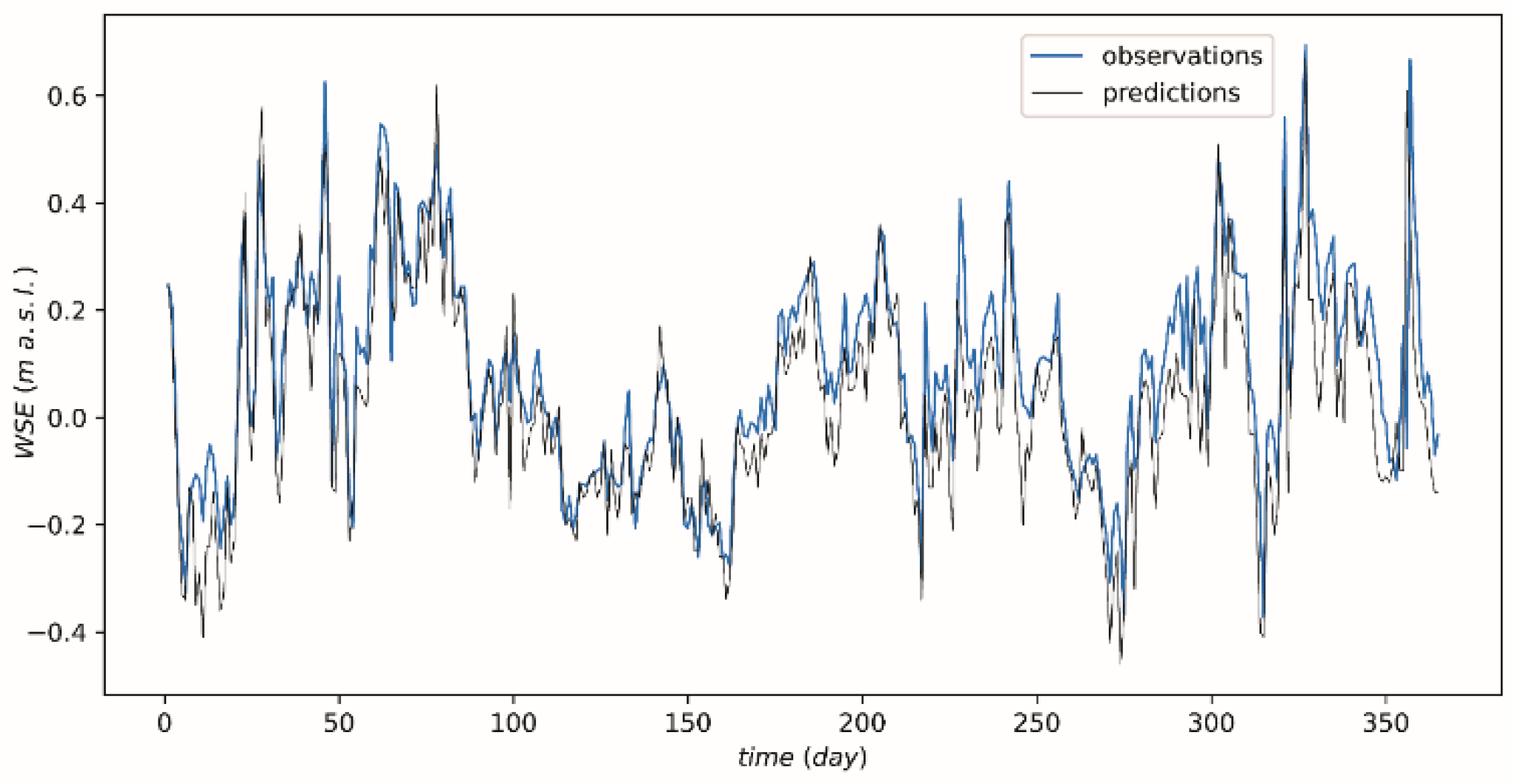
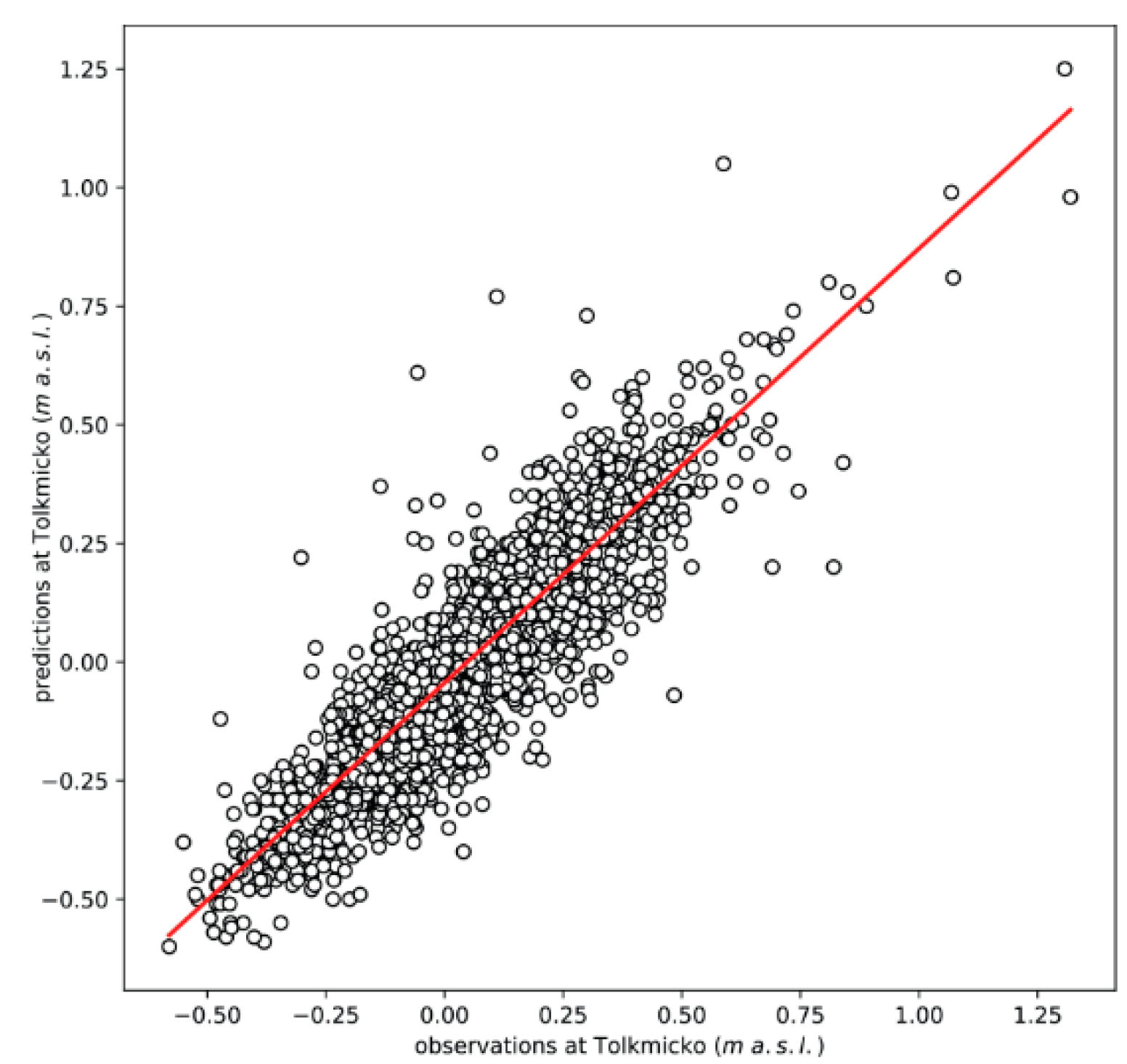
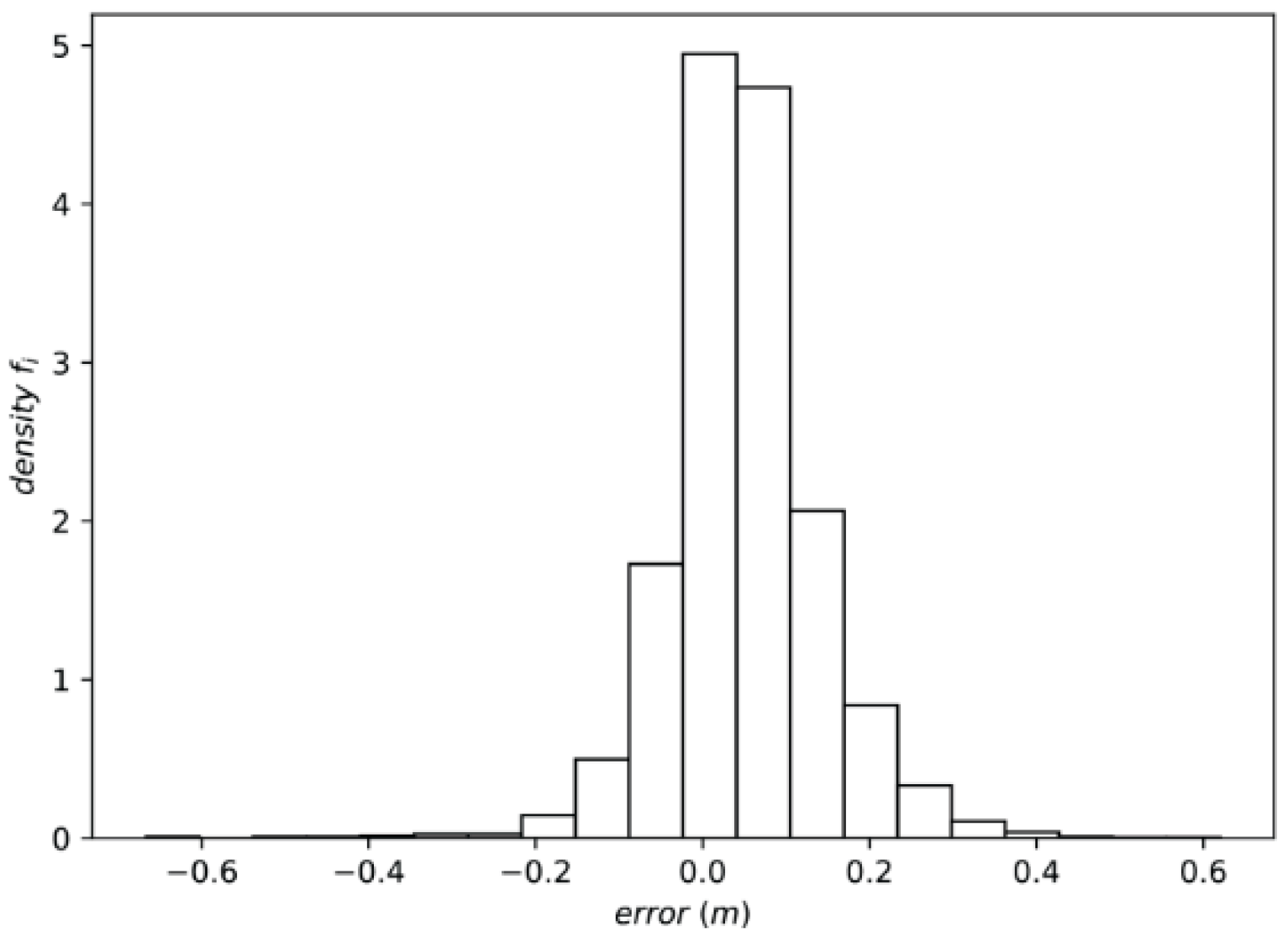
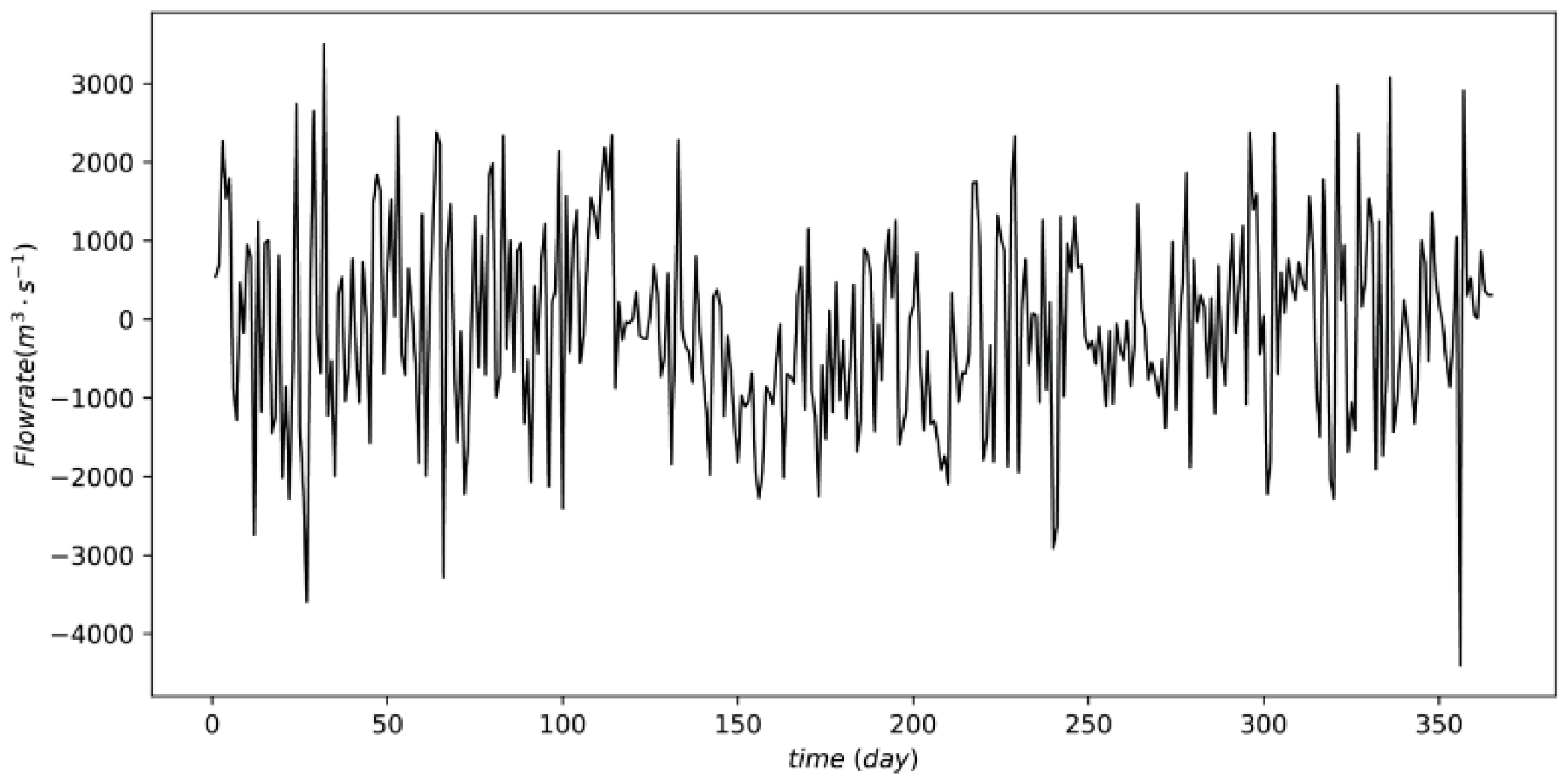
| Parameter | Tolkmicko | Hel |
|---|---|---|
| mean | 0.088 | 0.095 |
| std. dev. | 0.202 | 0.193 |
| minimum | −0.760 | −0.800 |
| q0.25 | −0.040 | −0.030 |
| median | 0.090 | 0.090 |
| q0.75 | 0.210 | 0.210 |
| maximum | 1.460 | 1.150 |
| Parameter | Observations | Computations | Error |
|---|---|---|---|
| mean | 0.059 | 0.010 | 0.049 |
| std. dev. | 0.198 | 0.203 | 0.092 |
| minimum | −0.580 | −0.600 | −0.667 |
| q0.25 | −0.060 | −0.120 | 0.000 |
| median | 0.060 | 0.010 | 0.045 |
| q0.75 | 0.179 | 0.130 | 0.096 |
| maximum | 1.319 | 1.250 | 0.620 |
| Value/Year | 2008 | 2009 | 2010 | 2011 | 2012 | 2013 | 2014 | 2015 | 2016 | 2017 | Average |
|---|---|---|---|---|---|---|---|---|---|---|---|
| Annual accumulative inflow (km3) | 17.78 | 15.40 | 15.76 | 16.23 | 16.35 | 15.42 | 14.31 | 16.50 | 15.18 | 15.73 | 15.87 |
| Annual accumulative outflow (km3) | 17.60 | 15.66 | 15.68 | 15.95 | 15.97 | 15.57 | 14.43 | 16.75 | 15.38 | 15.94 | 15.89 |
Publisher’s Note: MDPI stays neutral with regard to jurisdictional claims in published maps and institutional affiliations. |
© 2021 by the authors. Licensee MDPI, Basel, Switzerland. This article is an open access article distributed under the terms and conditions of the Creative Commons Attribution (CC BY) license (https://creativecommons.org/licenses/by/4.0/).
Share and Cite
Szydłowski, M.; Artichowicz, W.; Zima, P. Analysis of the Water Level Variation in the Polish Part of the Vistula Lagoon (Baltic Sea) and Estimation of Water Inflow and Outflow Transport through the Strait of Baltiysk in the Years 2008–2017. Water 2021, 13, 1328. https://doi.org/10.3390/w13101328
Szydłowski M, Artichowicz W, Zima P. Analysis of the Water Level Variation in the Polish Part of the Vistula Lagoon (Baltic Sea) and Estimation of Water Inflow and Outflow Transport through the Strait of Baltiysk in the Years 2008–2017. Water. 2021; 13(10):1328. https://doi.org/10.3390/w13101328
Chicago/Turabian StyleSzydłowski, Michał, Wojciech Artichowicz, and Piotr Zima. 2021. "Analysis of the Water Level Variation in the Polish Part of the Vistula Lagoon (Baltic Sea) and Estimation of Water Inflow and Outflow Transport through the Strait of Baltiysk in the Years 2008–2017" Water 13, no. 10: 1328. https://doi.org/10.3390/w13101328
APA StyleSzydłowski, M., Artichowicz, W., & Zima, P. (2021). Analysis of the Water Level Variation in the Polish Part of the Vistula Lagoon (Baltic Sea) and Estimation of Water Inflow and Outflow Transport through the Strait of Baltiysk in the Years 2008–2017. Water, 13(10), 1328. https://doi.org/10.3390/w13101328








